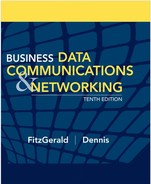APPENDIX D
CELLULAR TECHNOLOGIES
Cellular technology is becoming increasingly popular. Its most common use is to provide cellular telephone services, but the cellular network is also being used more and more often by data communication devices such as pagers, personal digital assistants (PDAs), and handheld computers.
Cellular technology is a form of high frequency radio in which antennas are spaced strategically throughout a service area. The service area is divided into many cells, each with its own antenna. This arrangement generally provides subscribers with reliable mobile telephone service of a quality almost that of a hardwired telephone system. Users (voice or data transmission) dial or login to the system, and their voices or data are transmitted directly from their telephone to one of these antennas. In this way, the cellular system replaces the hardwired local loop. Each phone service provider uses a different part of the radio frequency spectrum, which is why cell phones designed for one provider's network often won't work on another provider's network.
This network of cell antennas is an intelligent system. For example, as you drive your car through the service area, you move away from one antenna and closer to another. As the signal weakens at the first antenna, the system automatically begins picking up your signal at the second antenna. Transmission is switched automatically to the closest antenna without communication being lost.
The older technology used for cell phones is digital (not analog; see Chapter 3), and is sometimes called 2G wireless because it is the second-generation mobile phone service (old analog cell phones were the first generation). A 2G phone has a built-in CODEC that converts the analog voice data into digital signals for transmission. These phones enable limited data transfer, often only 19.2 Kbps, because the cell phone network was designed primarily for phone calls, not data transmission.
There are three incompatible standards for cell phone technology that are commonly used around the world. Code Division Multiple Access (CDMA) is a spread spectrum technology that works by digitizing multiple conversations, attaching a code known only to the sender and receiver and then dicing the signals into bits for transmission and reassembling them at the receiving device. Time Division Multiple Access (TDMA) allows multiple users to share the same voice channel by having each conversation transmitted alternately over short lengths of time (statistically time division multiplexing). Global System for Mobile Communication (GSM) is a TDMA-like digital system that transmits digital voice data in bursts during brief time slots allocated to multiple subscribers sharing a radio channel. GSM is the standard in most of the world, except for the United States and Canada, which still use a mix of CDMA, TDMA, and GSM.
The current technology for mobile wireless is 3G wireless, so called because it is the third generation of public wireless networks. 3G wireless is still under development with no clear winners at this point. Several industry groups are racing to provide high-speed digital telephone and wireless Internet services. Most “high-speed” cell technologies currently deployed are called 2.5G because they serve as a stepping stone to 3G. The adoption of 3G was relatively slow because mobile operators had to build new networks as 3G uses different frequencies than its predecessor 2G. The data transfer offered by 3G can be up to 2-3 Mbps, although this can drop down to approximately 300 Kbps when in motion.
Two sets of technologies are leading in the 3G race. The first is Enhanced Data GSM Environment (EDGE), a 2.5G step along the path to Wideband Code Division Multiple Access (WCDMA) as the 3G standard. As the name suggests, EDGE is an enhancement of the current GSM and provides a data rate of 384 Kbps (it is sometimes called GSM384). WCDMA provides 2.3 Mbps. For more information, see www.umts-forum.org.
The second technology group sponsors CDMA2000 (2.5G) and CDMA2000 1X (3G). As the names suggest, CDMA2000 and CDMA2000 1x are extensions to CDMA that provide 153 Kbps and 2.4 Mbps, respectively. For more information, see www.cdg.org.
Meanwhile, other vendors are beginning to talk about 4G wireless services—that is, the next generation after 3G—because 2–3 Mbps data rates are not as powerful as current wireless LAN technologies such as 802.11 (see Chapter 7). Some vendors have begun to call for universal public 802.11 access as a 4G option, with 802.11 hot spots being deployed in major urban areas. In other words, your cell phone would have both the 2.5G or 3G antenna, plus an 802.11 antenna to enable faster data transfer in areas covered by 802.11. While the standard version of 802.11 has a very short range, new emerging versions of 802.11 designed for outdoor use have ranges of 20 miles or more.
Stay tuned because this battle is just starting.
